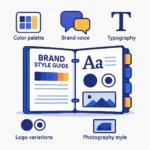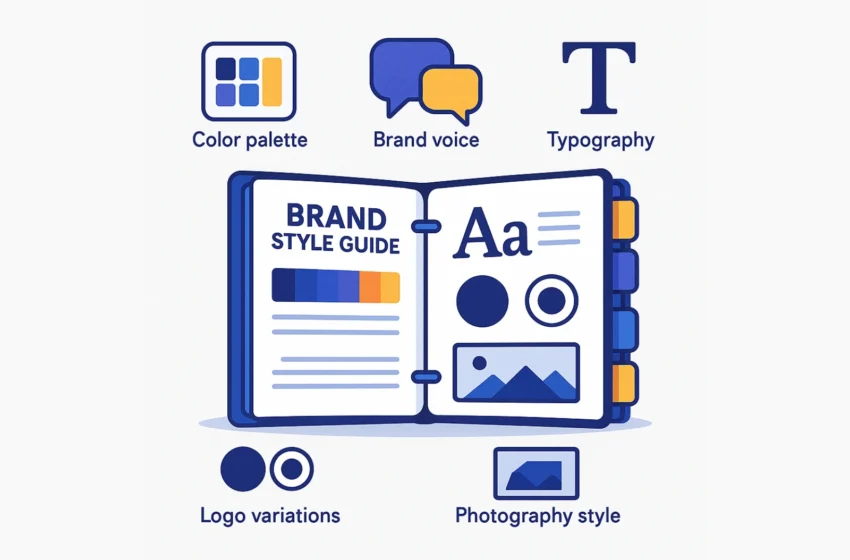
Creating a brand style guide is one of the most important steps in establishing a consistent and recognizable business identity. Your brand style guide serves as the definitive reference for how your company presents itself to the world, ensuring coherence across all platforms and touchpoints. In this comprehensive guide, we’ll walk through everything you need to know to create business branding guidelines that don’t just sit on a shelf but actually work for your organization.
Why Your Business Needs a Brand Style Guide
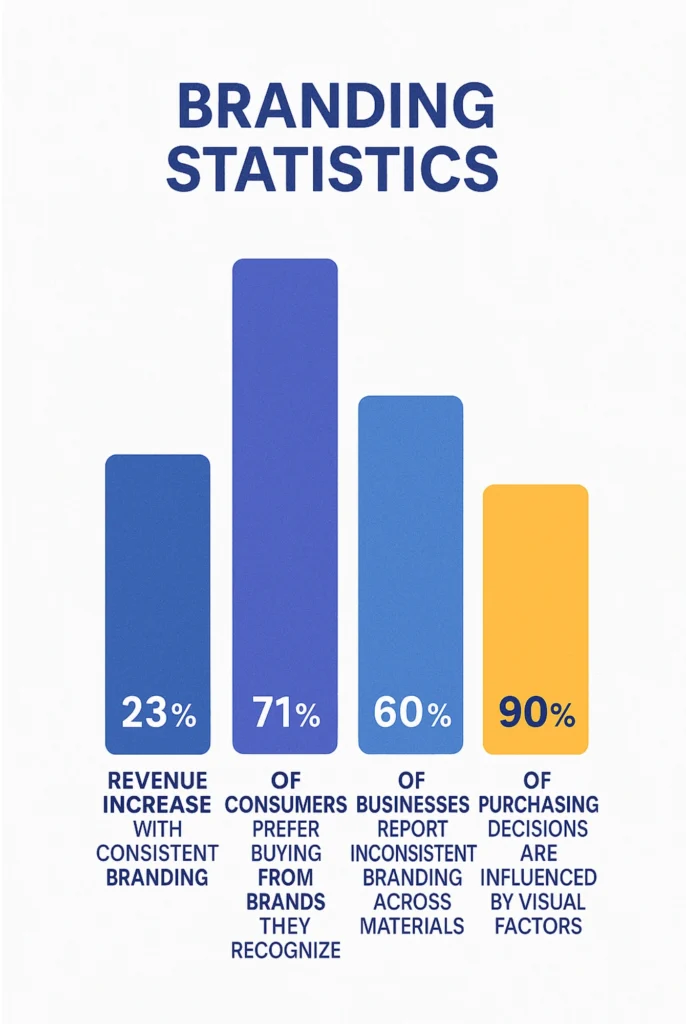
A brand style guide isn’t just a nice-to-have document—it’s a critical business asset. Without clear business branding guidelines, your company risks presenting an inconsistent image to customers, which can dilute brand recognition and undermine trust.
Brand consistency has been shown to increase revenue by up to 23%, according to Lucidpress. When every team member has access to the same standards and rules, your business communications become more professional, more cohesive, and ultimately more effective.
A well-crafted style guide:
- Saves time by eliminating guesswork about brand presentation
- Builds recognition through consistent visual and verbal elements
- Protects your brand’s identity as your team grows
- Provides clear direction for contractors and partners
- Creates a unified experience for customers across all touchpoints
Essential Components of an Effective Brand Style Guide
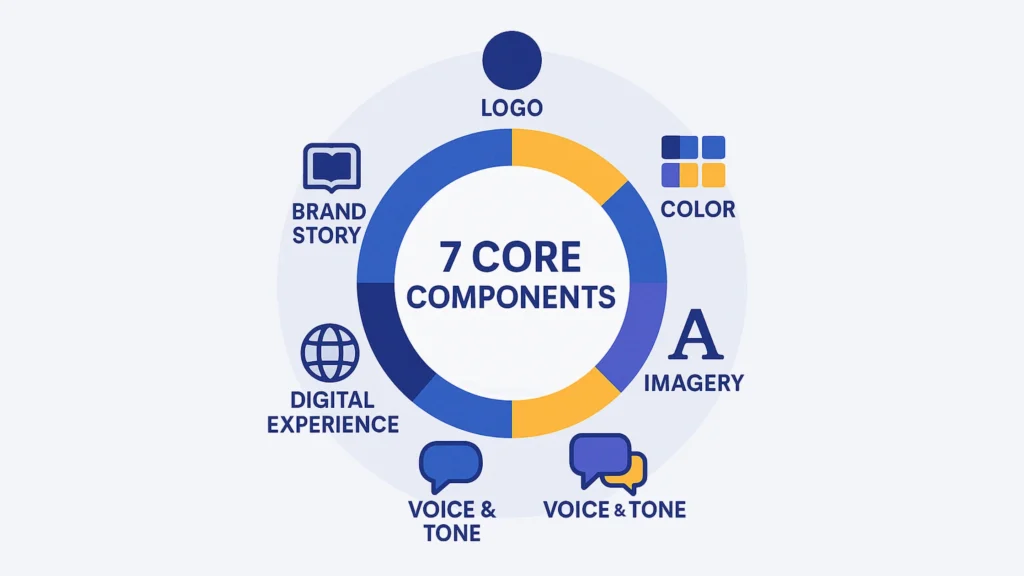
To create business branding guidelines that will actually be used, you need to include certain key elements. Let’s explore the core components that should be in every brand style guide:
1. Brand Story and Vision
Your brand style guide should begin with the “why” behind your brand. This section establishes the foundation for all other guidelines and helps ensure everyone understands the deeper purpose driving your visual and verbal choices.
Include:
- Mission statement that clearly articulates your company’s purpose
- Vision statement that describes your aspirational future
- Core values that guide your business decisions and culture
- Brand positioning that defines your unique place in the market
- Target audience profiles to keep customer needs top of mind
By starting with these fundamentals, you create context for all the specific guidelines that follow. Team members who understand your “why” can make better decisions when applying your brand standards.
2. Logo Usage Guidelines
Your logo is the most recognizable element of your brand identity. Clear guidelines for its use are essential for business branding.
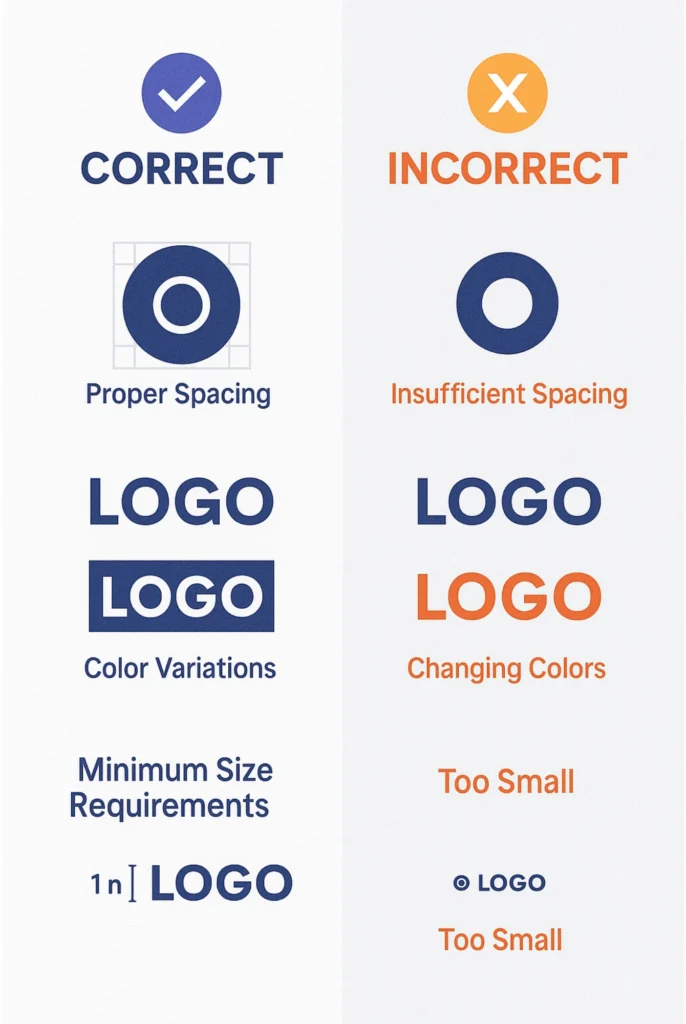
This section should cover:
- Primary logo specifications and variations (horizontal, vertical, icon-only)
- Minimum size requirements to maintain legibility
- Clear space rules to ensure your logo stands out
- Color variations (full color, black, white, reversed)
- Placement guidelines on different materials and backgrounds
- Prohibited uses with visual examples of what not to do
Include high-resolution downloadable files in multiple formats (PNG, JPG, SVG, PDF) to make it easy for team members to access the correct assets.
3. Color Palette Specifications
Colors evoke emotions and create instant recognition. Your business branding guidelines should provide comprehensive color specifications.
Include:
- Primary brand colors with their specific values (RGB, CMYK, HEX, and Pantone)
- Secondary color palette for supporting design elements
- Color hierarchy showing which colors to use predominantly and which sparingly
- Accessibility considerations for color combinations that meet WCAG standards
- Background/foreground pairings that work well together
Consider including examples showing how colors should be applied across different materials and contexts.
4. Typography and Font System
Typography is a powerful yet often overlooked aspect of brand identity. Clear font guidelines ensure your written communications maintain a consistent voice.
Specify:
- Primary and secondary typefaces for various applications
- Web-safe alternatives when custom fonts aren’t available
- Font hierarchy for headings, subheadings, body text, and captions
- Line spacing, letter spacing, and paragraph spacing standards
- Text formatting guidelines for bold, italic, and underlined content
- Font sizes across different formats (print, digital, presentations)
If using licensed fonts, include information about how team members can access them.
5. Imagery and Photography Style
The visual style of your photography and imagery significantly impacts how your brand is perceived. This section defines the aesthetic that represents your brand.
Cover:
- Photography style (candid vs. posed, lighting preferences, composition)
- Subject matter guidelines for what should be featured
- Editing specifications for filters, color grading, and effects
- Image sourcing information for stock photos or custom photography
- Icons and illustration style if applicable to your brand
Include plenty of examples showing “on-brand” imagery versus imagery that doesn’t align with your brand identity.
6. Voice and Tone Guidelines
Your brand’s verbal identity is just as important as its visual identity. Business branding guidelines should include standards for how your brand communicates.
Define:
- Brand voice characteristics (formal vs. casual, serious vs. playful)
- Tone variations for different audiences and situations
- Grammatical preferences (Oxford comma, numerals vs. spelled-out numbers)
- Industry terminology and how to use it correctly
- Words and phrases to use (and those to avoid)
- Content structures for common communications
Provide plenty of before-and-after examples to illustrate how your voice and tone should be applied in real communications.
7. Digital Experience Standards
Today’s brands exist largely in digital spaces. Your guide should address how your brand appears online.
Include:
- Website design elements and UI components
- Social media profile standards for various platforms
- Email marketing templates and design elements
- Digital ad specifications and creative guidelines
- Video and animation style guidelines
This section should align with your other brand elements while addressing the unique requirements of digital media.
Creating a Brand Style Guide That People Actually Use
Having comprehensive business branding guidelines is only valuable if people actually follow them. Here are strategies to ensure your style guide becomes a living, breathing document:
Make It Accessible to Everyone
The most effective brand style guides are easily accessible to anyone who needs them. Consider these implementation strategies:
- Create a digital, searchable version that can be updated as needed
- Develop a simplified one-page “cheat sheet” for quick reference
- Use a cloud-based platform that always shows the most current version
- Create interactive elements like color palette pickers or logo downloaders
Many companies find success using platforms like Notion, Figma, or specialized brand management software to host their guidelines, making them both accessible and interactive.
Include Real-World Applications
Abstract guidelines can be difficult to apply. Help your team understand how to implement your business branding guidelines by showing real-world applications:
- Social media post examples showing correct formatting and visual style
- Email template examples with proper logo placement and typography
- Presentation slide layouts that follow your brand standards
- Document templates for common business communications
- Signage and environmental graphics examples
These practical examples bridge the gap between abstract rules and daily implementation, making your guide more useful and actionable.
Build in Flexibility While Maintaining Consistency
One reason style guides often go unused is that they’re too rigid to apply in real-world situations. Build flexibility into your business branding guidelines by:
- Providing decision trees for common design challenges
- Creating tiered guidelines that distinguish between “must-follow” rules and “when possible” recommendations
- Addressing exceptions for specific channels or circumstances
- Including adaptation guidelines for international markets or special campaigns
The most effective brand style guides give team members enough direction to maintain consistency while allowing for creativity and adaptation to different contexts.
Beyond the Basics: Advanced Brand Style Guide Elements
Once you’ve established your core business branding guidelines, consider these advanced elements to take your brand consistency to the next level:
Brand Architecture
For businesses with multiple products, services, or sub-brands, defining the relationship between these elements is crucial:
- Brand hierarchy showing how parent and child brands relate
- Naming conventions for new products or services
- Co-branding guidelines for partnerships and collaborations
- Brand extension principles for entering new categories
This framework ensures your brand can grow while maintaining its core identity.
Motion and Sound Identity
As digital experiences become more immersive, consider adding guidelines for:
- Animation principles that reflect your brand personality
- UI motion standards for interactive elements
- Video intro/outro treatments for consistent video branding
- Sound logo or audio branding elements
These dynamic elements add another dimension to your brand experience and require clear guidelines to maintain consistency.
Accessibility Standards
Modern business branding guidelines should address accessibility to ensure your brand is inclusive:
- Color contrast requirements for text legibility
- Alternative text guidelines for images
- Accessible file format recommendations
- Inclusive language guidelines
Building these standards into your brand guide demonstrates your commitment to reaching all audiences and may help you meet legal requirements in many jurisdictions.
Implementing Your Brand Style Guide Across Your Organization

Creating your guide is just the first step. Successful implementation requires a strategic approach:
Training and Onboarding
Help your team understand and apply your business branding guidelines:
- Conduct brand training sessions for different departments
- Create onboarding materials specifically about brand standards
- Develop role-specific quick guides tailored to common tasks
- Offer regular “office hours” for brand questions
These initiatives help build brand literacy throughout your organization.
Regular Updates and Evolution
Your brand style guide shouldn’t be static. Plan for evolution:
- Schedule periodic reviews to assess what’s working and what’s not
- Create a feedback mechanism for team members to suggest improvements
- Document version history to track changes over time
- Communicate updates clearly when they occur
A living document that evolves with your company will remain relevant and useful.
Measuring Brand Consistency Success
How do you know if your business branding guidelines are working? Establish metrics:
- Conduct regular brand audits across channels and materials
- Track brand recognition metrics through customer research
- Monitor design efficiency in your creative processes
- Check for reduction in brand-related questions from team members
These measurements help you demonstrate the ROI of your brand style guide.
Common Pitfalls to Avoid in Brand Style Guide Creation
Even well-intentioned brand guidelines can fail for predictable reasons. Watch out for these common mistakes:
Making It Too Complex
Overly detailed guidelines can overwhelm users. Focus on clarity:
- Prioritize the most important elements rather than trying to cover everything
- Use plain language instead of design jargon
- Break information into digestible chunks
- Include a glossary for necessary technical terms
The best business branding guidelines find the sweet spot between comprehensive and accessible.
Focusing Too Much on Design, Not Enough on Application
Guidelines that only address how things should look, without explaining how to implement them, are frustrating for users:
- Include practical how-to instructions alongside visual examples
- Provide templates and tools that make implementation easier
- Address common questions and challenges your team faces
- Show before-and-after examples of brand standards in action
Making your guide practical ensures it becomes a useful reference rather than an aspirational document.
Ignoring Input from Key Stakeholders
Brand guidelines created in isolation often miss important practical considerations:
- Involve representatives from different departments during development
- Consider the needs of both internal teams and external partners
- Test draft guidelines with actual users before finalizing
- Get buy-in from leadership to ensure organizational support
Including diverse perspectives results in more comprehensive and workable guidelines.
Building a Culture of Brand Consistency
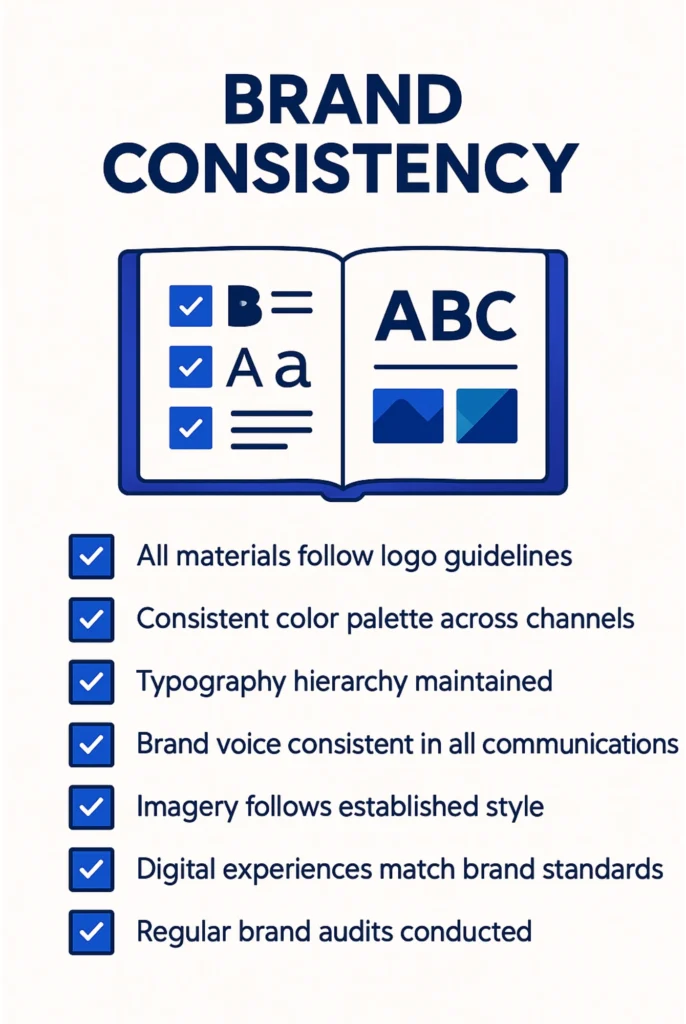
The most successful business branding guidelines are supported by organizational culture:
Designate Brand Champions
Identify individuals across departments who can:
- Provide guidance on brand application questions
- Review materials for brand compliance
- Share brand success stories with their teams
- Communicate updates to brand standards
These champions extend the reach of your brand management beyond a single department.
Celebrate Good Brand Implementation
Recognize and reward those who implement your brand guidelines effectively:
- Share excellent examples of brand application company-wide
- Create a brand implementation award for standout work
- Highlight success stories in company communications
- Use strong brand executions as case studies in training
Positive reinforcement helps build a culture where brand consistency is valued.
Make Brand Resources Part of Your Workflow
Integrate brand guidelines into everyday processes:
- Add brand checkpoints to project approval workflows
- Include brand standards questions in creative briefs
- Incorporate brand guidelines links in templates and tools
- Build brand compliance into performance reviews for relevant roles
These integrations help make brand consistency a habit rather than an afterthought.
Conclusion
A brand style guide isn’t just a rulebook—it’s a strategic blueprint that fuels recognition, trust, and long-term value. By weaving consistency into every touchpoint, your guide becomes a dynamic tool that empowers teams, adapts to market shifts, and amplifies your competitive edge.
At Legendary Ideas, we craft style guides that do more than unify visuals—they embed your brand’s DNA into every decision. Our approach ensures:
- Clarity & Consistency: Streamlined guidelines for logos, typography, and tone.
- Future-Proof Flexibility: Room to evolve without losing brand integrity.
- Business Impact: Stronger recognition, customer loyalty, and market positioning.
Why settle for static documents when you can have a living asset that drives growth? Partner with us to design a style guide that grows with your brand, not against it.

